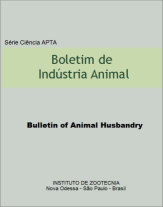Feed efficiency and reranking of beef cattle at different stages of development
Palabras clave:
feedlot, Nellore, residual feed intakeResumen
The Residual Feed Intake (RFI) is a measure of feed efficiency usually evaluated post-weaning, and according to available evidences in the literature is highly correlated to RFI measured at other ages. The objective of present study was examining the reclassification of RFI in Nellore bulls classified in two post-weaning tests. In post-weaning performance test 127 Nellore males (210 ± 45 days of age) in feedlot collective pens (GrowSafe Systems®) were evaluated. Data of dry matter intake (DMI, 7.23 ± 1.72 kg/day) and mean body weight (BW, 306.72 ± 7.54 kg) were collected during 112 days, and the animals were classified according to RFI. The RFI was estimated as multiple regression error of DMI on average daily gain (ADG) and metabolic weight (BW0.75). Thereafter, a sample of 24 animals (408 ± 45 days old), 12 high (2.34 ± 0.24 kg DM/day) and 12 low RFI animals (-1.48 ± 0.24 kg DM/day) were reclassified after performance post-weaning test in feedlot for 84 days in individual pens. The diet was offered twice daily, contained corn silage (53.6% DM), Urochloa hay (10.0% DM), ground corn (21.8% DM), soybean meal (11.6% DM) and mineral supplement (3.0% DM). The experimental design was completely randomized. Data were analyzed using GLM procedure (SAS Inst., Inc., Cary, NC), fitting a model including the fixed effects of RFI class and the initial weight as linear covariate. Means were adjusted by the least squares method and compared by the Tukey test (P<0.01). The 24 animals reclassified in performance post-weaning, 33.3% retained the class of RFI established in the post-weaning performance, and 66.7% of the animals changed RFI class on 0.5 standard deviation from the mean. On the other hand, 16.7% of the animals changed from high to low RFI class, and 12.5% changed from high to medium RFI class (Table 1), showing improvements in feed efficiency. These results indicate that there is reranking of RFI in Nellore young bulls at different stages of development with same diet.Descargas
Descargas
Publicado
Número
Sección
Licencia
Os autores não serão remunerados pela publicação de trabalhos, pois devem abrir mão de seus direitos autorais em favor deste periódico. Por outro lado, os autores ficam autorizados a publicar seus artigos, simultaneamente, em repositórios da instituição de sua origem, desde que citada a fonte da publicação original seja Boletim de Indústria Animal. A revista se reserva o direito de efetuar, nos originais, alterações de ordem normativa, ortográfica e gramatical, com vistas a manter o padrão culto da língua e a credibilidade do veículo. Respeitará, no entanto, o estilo de escrever dos autores. Alterações, correções ou sugestões de ordem conceitual serão encaminhadas aos autores, quando necessário. Nesses casos, os artigos, depois de adequados, deverão ser submetidos a nova apreciação. As opiniões emitidas pelos autores dos artigos são de sua exclusiva responsabilidade. Todo o conteúdo deste periódico, exceto onde está identificado, está licenciado sob a Licença Creative Commons Attribution (CC-BY-NC). A condição BY implica que os licenciados podem copiar, distribuir, exibir e executar a obra e fazer trabalhos derivados com base em que só se dão o autor ou licenciante os créditos na forma especificada por estes. A cláusula NC significa que os licenciados podem copiar, distribuir, exibir e executar a obra e fazer trabalhos derivados com base apenas para fins não comerciais.













